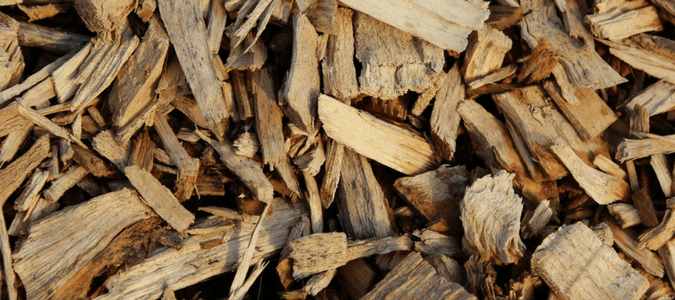
There are all kinds of gardens in the world, and the most gorgeous ones might have many unique features—native plants that vary from region to region, for example, or a particular gardener’s own artistic stamp on the landscape design. But nearly all the world’s most lush and beautiful gardens have something in common: They use mulch to help keep undesirable weeds away and keep plants, flowers, trees and vegetables thriving. This is because every good gardener knows the benefits of mulching.
Mulch isn’t very complicated or mysterious. At its base, mulch is nothing more than a material, usually something opaque, that is applied over the soil in a garden in order to produce healthier and lower-maintenance plants. Sounds simple, right? Yet the benefits of mulching are many, and they apply to nearly all types of plants and gardens. Whether you’re mulching a flower bed or vegetable garden, applying mulch around trees or even just delineating an area of an architecturally appealing outdoor space, mulching is a relatively simple task, and it’s a good idea in any climate and every season.
How can something so simple be so universally versatile and beneficial? Let’s explore the many good reasons and methods for using mulch in your garden or yard.
Depending on which type of mulch you use, there are many possible benefits, including:
- Preventing the growth of weeds, which helps other plants grow by eliminating competition for water and nutrients
- Keeping soil moist, so you don’t need to water your garden as often
- Keeping soil from becoming too warm or too cold, which helps plants survive through heat waves and cold snaps
- Keeping soil from eroding or getting compacted after a heavy rain
- Keeping flowers, fruits and vegetables from getting dirt on them, which helps prevent plant diseases and also makes veggies easier to wash
- Giving your garden a neat, attractive appearance
If you use organic mulch, the mulch will also benefit the soil itself, as the organic material in the mulch decays over time, improving the soil’s composition and quality. This can improve your plants’ root growth while keeping the soil nice and loose, which makes it more conducive to water infiltrating its depths and benefiting the plants. Organic mulch also creates an optimal environment for earthworms and other beneficial organisms that further promote a healthy garden.
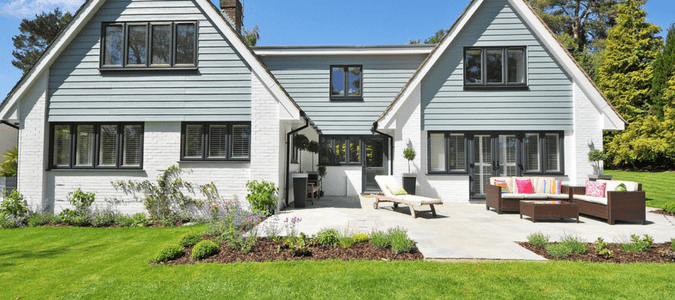
Best Type of Mulch To Use Around House and Yard
There are both organic and inorganic types of mulch available for use for a variety of gardening purposes. Which is the best type of mulch for you to use around your garden or outdoor living space? Generally speaking, organic mulch offers more benefits for plants and soil than inorganic mulch. Still, deciding which type of mulch you should use depends on your purpose as well as the look you want to achieve.
Assuming you want weed control, moisture retention and a neat, finished appearance for your plants—arguably the top three reasons most gardeners and homeowners use mulch—you may choose one of the following types of mulch:
- Bark or wood chips, one of the most common mulch varieties that gardeners use. Most bark or wood chip mulch is made from wood like cedar or pine, which look and smell wonderful. If you’re planning to mulch a pathway or a sloped area with bark or wood chips, consider using a shredded variety. Shredded mulch breaks down faster than the chip variety, but it won’t wash away as easily in a heavy rainstorm.
- Compost or shredded leaves are also a very common choice, and often available right in your own garden. Just make sure the compost you use isn’t moldy and wasn’t made from leaves, plants or other materials that contained pesticides, as the mulch’s contents will seep into the soil over time.
Bark and wood chip mulch is available in bags or in bulk from your local garden center or hardware store. Compost and shredded leaf mulch might be available for sale at a garden center, or you can use leaves and homemade compost from your own garden.
You’ll also have options regarding the size of the mulch pieces, so keep in mind that smaller, finer pieces are easier to apply to close-set, smaller areas, such as in flower beds. Larger, coarser pieces are fine for larger spaces or around bigger plants like trees or large shrubs. Coarser mulch varieties tend to last longer than finer ones, and they let more water and air reach the soil, but as previously noted, they’re more likely than finer mulch varieties to wash away during heavy rains. Since finer mulch doesn’t allow as much water or air through, it’s a good choice for walkways or any areas that you want to keep plant-free.
Some other, less common options for mulching material include straw or hay, which can be a very healthy choice for a vegetable garden—but do be aware that hay can introduce weeds—and pine needles, which work best with plants like blueberries or rhododendrons that thrive in high-acidity soil.
Some gardeners like using cocoa bean hulls as mulch since they have an attractive look, color and scent, but it’s important to know they contain a chemical that is very toxic to certain animals, including cats and dogs. Pet owners and animal lovers would do well to choose a different type of mulch for their gardens.
Inorganic mulches, such as rocks, rubber chips or plastic sheeting, won’t improve soil quality the way organic mulches do, yet these make sense for certain gardens and purposes. Black plastic sheeting, for example, can be very effective in keeping your soil moist and warm in a vegetable garden. Rocks can be an attractive, decorative choice that calls arid, desert-like landscapes to mind. Just note that inorganic mulches can be difficult to remove once installed, so they may not be the best choice if you like switching things up in your garden—changing the landscape design, for example, or switching out plants according to the season.
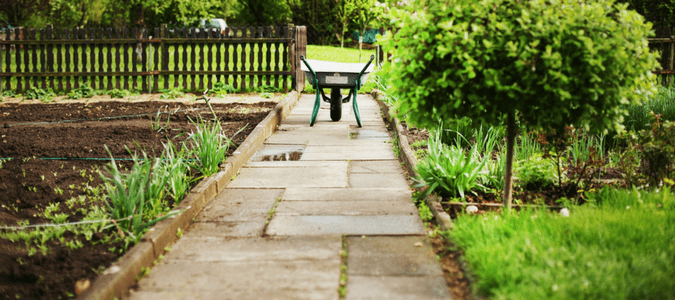
How To Mulch Flower Beds
Wondering how to mulch flower beds? Good news: It’s a pretty straightforward job. For flowers and most other mulching projects, you’ll need a wheelbarrow, a shovel, a rake and protective gloves, and perhaps a smaller tool like a hand rake as well.
No matter where you’re using mulch or for what particular purpose, you should always mow (if needed) and remove weeds first, and then water the soil thoroughly. Once you’ve mowed, weeded and watered, use your wheelbarrow to transport a bag or pile of mulch to the desired area. Dump it out or use your shovel or your hands to distribute it around the area, and then use your rake (or hand rake, in smaller areas like flower beds) to spread it out in an even layer.
When mulching flower beds, a two-inch layer should be plenty to keep weeds at bay and help flowers thrive. Leave a radius of several inches around the base of the flower plants free of mulch, to avoid problems with mold and disease.
As far as when to mulch your garden, as a general rule of thumb, organic mulch should be applied either in late spring, after the ground has begun warming up, or late in the fall season, before the first deep freeze but after the soil has been soaked by the first heavy rain. You can also re-apply mulch in the summertime, if needed. If you’re planning to use mulch in a vegetable garden, be sure to wait to apply mulch until after the soil has already started warming up with the weather, for optimal seed germination and plant growth.
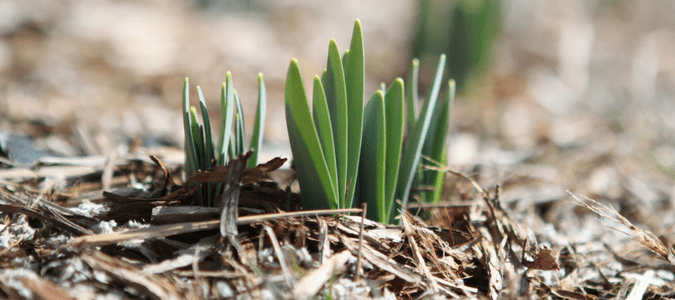
Laying Mulch Over Weeds
Speaking of weed removal, laying mulch over weeds is an excellent weed-control method, and there are several ways to do it. As mentioned earlier, hay isn’t a good choice of mulch for weed-control purposes, and rocks are also not a very effective weed barrier, at least not when used on their own. Many other types of mulch, however, including bark and wood chips, compost, newspapers, cardboard and plastic sheeting, offer protection against weeds.
The process of laying mulch over weeds is basically the same as mulching any other area of your yard or garden: Pull weeds and mow first, then water, and then lay down your choice of weed-barrier mulch.
If killing off pesky weeds, grass or other unwanted ground cover is your primary goal, a great option is using corrugated cardboard or several layers of newspaper to create a sunlight-impermeable surface. Be sure to tamp down the newspaper or cardboard by watering it thoroughly after you’ve laid it over the soil, so it won’t blow away with the first gust of wind. Once you’ve covered every area you want weed-free, top it off with several inches of shredded leaves or wood chip mulch.
If you use the cardboard or newspaper method, don’t worry about the plants that you do want to stay healthy. Water can permeate both materials well enough to keep the soil below damp. Be sure to leave several inches’ worth of space around the bases of any plants you’re preserving, and they’ll receive plenty of water from your hose or sprinkler or the rain. Also, be sure to use only black-and-white-ink newsprint—no color ink, as it can be toxic as it leaches into the soil.
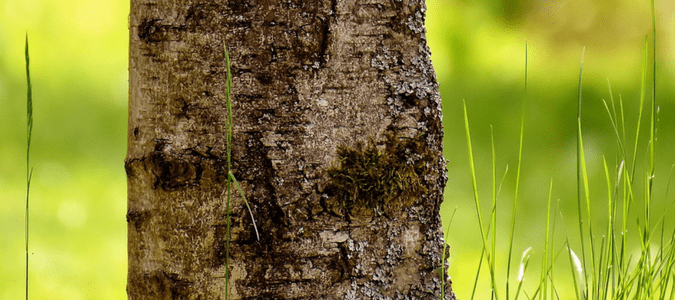
How To Apply Mulch Around Trees
Mulching around the bases of your trees is a great way to keep their roots healthy, and healthy roots grow healthy trunks and canopies. Again, mulch helps soil retain moisture and controls its temperature; this keeps the tree’s roots from getting too cold during a frost or too warm during the dead of summer. Using organic mulch feeds your trees by keeping a steady influx of nutrients seeping into the soil, as the mulch decays over time.
Mulch can be applied a bit more thickly around trees than around flower beds; three or four inches deep is sufficient. Spread it in a circle around the tree’s base, making sure, as always, to keep it at least three inches away from the base of the trunk in order to prevent bark decay.
When the mulch you’ve applied around your trees has reduced in volume by half, it’s time to apply fresh mulch. Depending on which type you’ve used, this might take anywhere from several months to up to a year or longer.
ABC Can Keep Your Yard Looking Great
Mulching is a relatively easy and affordable process, and it has great benefits for your yard, garden and soil—but many homeowners just don’t have the time to devote to this important task. Some homeowners have mobility or other health issues that prevent them from doing vigorous outdoor work. If your garden is in need of mulching but you’re not in a position to do the work yourself, call on ABC Home & Commercial Services to help. We will work with you to determine the best type of mulch for your plants’ or garden’s needs, and we’ll use our expertise to create a beautiful, thriving outdoor space that you can be proud of.
